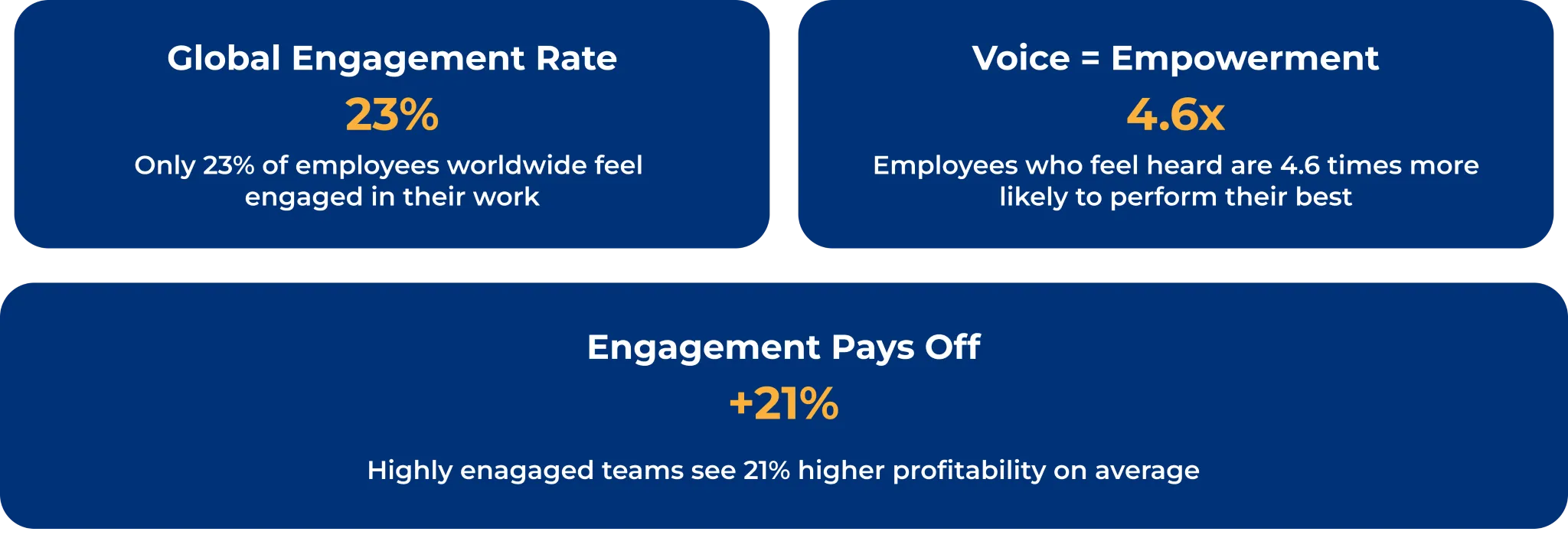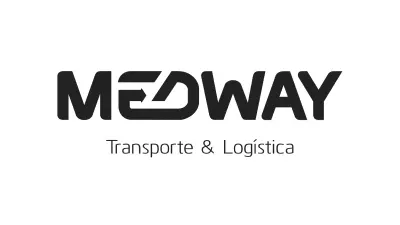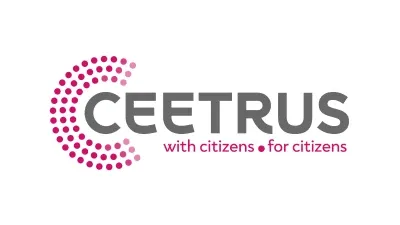Why Employee Engagement Starts with Your Intranet
Table of Contents
- Introduction
- The Engagement Challenge in Hybrid Workplaces
- Give Employees a Voice on the Intranet
- Recognize and Celebrate Success (Publicly)
- Build Community and Strengthen Culture Online
- Leadership Communication: Trust Through Transparency
- Practical Tips: Using Your Intranet to Drive Engagement
- Conclusion: Make Your Intranet the Heart of Engagement
- FAQs
Introduction
In today's hybrid workplaces, many employees feel disengaged or disconnected. Teams are spread across offices and home environments, and traditional top-down communication (like mass emails or static newsletters) often falls flat. The result? Employees tune out. In fact, only 21% of employees worldwide are engaged at work, meaning nearly four in five are not. This disengagement isn’t just a morale issue; it can drag down productivity, innovation, and ultimately business performance. The good news is that improving engagement doesn’t require fancy perks or constant team outings. One of the most powerful tools to connect and motivate your people is likely right in front of you: your company intranet. A modern intranet is not just an information repository or digital bulletin board – it’s a dynamic hub for conversation, recognition, and community building. When used well, it becomes the cornerstone of a vibrant workplace culture and a driver of a great employee experience. To convince even the most skeptical HR or Internal Communications leader, let’s explore why employee engagement truly starts with your intranet – and how to unlock its full potential.

Card with data points mentioned along article.
The Engagement Challenge in Hybrid Workplaces
Disconnected teams and one-way communication are undermining engagement. In a hybrid work era, employees can easily feel like cogs in a machine, especially when communications are strictly top-down. Think about the typical corporate email blast or monthly PDF newsletter – it pushes out information but invites no interaction. The lack of feedback or discussion sends a subtle message: just listen, don’t speak. Over time, this dynamic erodes enthusiasm. Employees may miss important updates, feel unheard, or simply stop caring.
The statistics reflect this challenge. In the U.S., just about one in three employees feels truly engaged in their work, and globally it’s only about one in five. That leaves a vast majority either checked out or actively disengaged. And hybrid work can exacerbate the problem: remote staff might be left out of informal office chatter, while in-office staff rely on outdated intranet portals that few bother to check. It’s no wonder many workers report feeling out of the loop. Traditional internal communication tools – passive intranet pages, email cascades – simply aren’t capturing employees’ hearts or minds.
Why do the old methods fail? They’re one-way streets. An all-company memo might convey information, but it doesn’t spark involvement. When employees can’t comment on an announcement, congratulate a colleague, or ask a question about a new policy, they remain passive recipients. In contrast, engagement thrives on interaction. People become engaged when they can participate, converse, and see the impact of their voice. This is precisely where a modern intranet comes in.
Give Employees a Voice on the Intranet
One of the most powerful ways an intranet boosts engagement is by flipping the communication model from monologue to dialogue. A modern intranet enables two-way communication at all levels. Instead of just reading a top-down announcement, employees can comment on news posts, ask leadership questions in Q&A forums, or share their own updates.
Why is giving employees a voice so critical? When people feel heard, they feel valued. In fact, research shows that employees who feel their voice is heard are 4.6 times more likely to feel empowered to perform their best work. This empowerment naturally fuels engagement – when staff see that their feedback can lead to action or at least thoughtful response, they invest more of themselves in the company’s success.
Modern intranet platforms come with features tailor-made for amplifying employee voices:
🔹Comments and Discussions:
Every news article or update can allow comments. Employees can ask for clarifications on the new HR policy posted by HR, or simply thank leadership for a transparent update. These comment threads turn static news into conversations, where employees at any level can weigh in.
🔹Discussion Forums & Communities:
The intranet can host discussion boards for various interests or projects, where any member of the organization can start or join a thread. Unlike endless reply-all email chains, forums are organized and open to all, preserving valuable ideas and answers.
🔹Surveys and Polls:
Quick pulse polls embedded in the intranet homepage let employees give input on decisions (“Where should we hold the team off-site?” or “Vote on next charity initiative”). It shows employees that leadership cares about their opinions and also gives management early insight into sentiment.
🔹Ideation Platforms:
Some intranets include an “ideation hub” where employees can suggest ideas (for a new product feature, a process improvement, a cultural initiative) and colleagues can upvote or discuss them. For instance, the Coimbra Hospital Center’s intranet introduced an ideation lab for sharing and developing ideas that invites staff contributions across all departments. When people see their suggestions considered – or even implemented – it’s a huge engagement boost.
Imagine an environment where a frontline employee’s idea sparks a new business opportunity, or where after a town hall video on the intranet, dozens of employees share reactions and follow-up questions in the comments, generating a real dialogue. That is the kind of lively exchange a modern intranet can facilitate. Over time, these interactions create a culture of openness. Employees stop feeling like information is just pushed at them; instead, they’re part of an ongoing conversation. And with conversation comes connection.
Importantly, this two-way communication also builds transparency and trust. When leadership is willing to hear and respond to feedback on the intranet openly, it signals confidence and authenticity. Intranets such as Diggspace have been used in forward-thinking organizations to break down silos. A modern intranet eliminates siloed communication, providing open channels for employees to share ideas, ask questions, and offer feedback in real time. By making communication a two-way street, your intranet transforms from a static info dump into the interactive heartbeat of your internal communications.
Transform your Company's engagement today.
Recognize and Celebrate Success (Publicly)
Engagement isn’t just about communication – it’s also about appreciation. Everyone wants to be acknowledged for their contributions. A modern intranet offers creative and far-reaching ways to celebrate employees, turning recognition into a shared experience that uplifts morale across the organization.
Think about the difference between a private “thank you” email from a manager versus a public shout-out on the intranet’s front page. The public praise not only makes the individual employee feel great, it also inspires others and reinforces what “great work” looks like in your culture. Recognition is contagious. Here’s how your intranet can leverage that:
🔹Shout-Outs and Kudos:
Build a culture of appreciation by allowing anyone to post a kudos or shout-out. For example, an intranet might have a dedicated “Wins & Shout-Outs” feed where team members tag a colleague and write a brief note of praise (“Kudos to Alex Lee for nailing the client presentation this week!”). Others can then comment or leave virtual high-fives (via reactions). Imagine a sales team using an intranet’s kudos feature to celebrate big wins – the whole company can see the victory, congratulate the salespeople, and feel pride in the team’s success. This visibility boosts morale across offices, because every success becomes a shared celebration rather than a siloed pat on the back.
🔹Badges and Gamification:
Many modern intranets let you award digital badges for achievements or contributions. Completing a project might earn a “Project Hero” badge on one’s profile; mentoring a new hire could earn a “Coach” badge. It may sound playful, but these tokens of appreciation can motivate employees to engage more with the platform (who doesn’t like collecting badges?) and with their work. Leaderboards or achievement showcases on the intranet can spark friendly competition in the service of company goals.
🔹Employee of the Month Spotlights:
Employee of the Month Spotlights: Going beyond one-line kudos, the intranet can host monthly or weekly features that highlight an employee’s story and accomplishments. Not only does this recognize the individual, it helps others get to know a colleague better – strengthening personal connections and the sense that people are at the heart of the company, not just roles.
The impact of recognition on engagement is profound. When employees feel appreciated, they naturally become more invested. Consider this: 93% of employees who feel appreciated for their work report being more engaged. The intranet is an ideal vehicle for amplifying appreciation because it reaches everyone. A kind word said aloud in an office only reaches the people in the room, but a kind word posted on the intranet can be seen by hundreds, spreading positive energy.
Public recognition also reinforces desired behaviors and values. For example, if your company values teamwork, spotlighting a cross-functional team’s achievement on the intranet sends a clear message that collaboration is rewarded. Over time, these stories shape a culture where employees feel valued and motivated to excel. And when people know their good work will be noticed and celebrated, they engage more wholeheartedly in their jobs.
Build Community and Strengthen Culture Online
Beyond voice and recognition, engagement flourishes when people feel a sense of belonging. A strong company culture isn’t confined to physical office walls – it can be nurtured online through your intranet’s community features. A modern intranet serves as a digital town square or social hub where employees can connect not just about work, but as humans with interests, ideas, and personalities.
How does an intranet build community? Consider some features and their benefits:
🔹Interest Groups and Communities:
Modern intranets often let employees create or join groups based on common interests or affinities – whether work-related (e.g., a “UX Designers Group” to share design tips) or personal (a “Book Club” or “Marathon Runners” group open to anyone in the company). These communities break down departmental barriers and geographical distance. An engineer in one office and a marketer in another might bond over gardening in an intranet hobby group, forming a friendship that translates into a stronger sense of loyalty to the company. Dedicated spaces for interest-based communities help connect people and build a sense of belonging.
🔹Profile Pages and People Directories:
A simple but powerful feature: each employee can have an intranet profile with not just title and contact info, but maybe a photo, bio, and fun facts or skills. When someone new joins, colleagues can quickly learn about their background and maybe discover shared interests. At Medway, implementing detailed intranet profiles meant employees could get to know their colleagues better, which strengthened relationships across departments. The intranet essentially humanizes everyone in the organization, which is critical for a positive workplace culture.
🔹Welcoming Newcomers:
Introducing newcomers to their colleagues can be a great way to make people feel included right from the start. Simply publishing an article welcoming a new hire gives people the opportunity to welcome them and get to know them from the comments, which increases everyone's sense of belonging.
🔹Company Events and Activities:
Your intranet can be the central calendar and bulletin board for all company happenings – from the next all-hands meeting to the Friday virtual yoga class. By centralizing event info and letting people RSVP or comment (“Looking forward to this!”), you encourage participation. Post-event, you might share photo galleries or highlights on the intranet, so even those who couldn’t attend feel included and can comment on what happened.
All these community-building elements contribute to what we call a digital workplace culture. It’s the equivalent of water-cooler chats, recreational clubs, and bulletin boards moved online – with the advantage that everyone (even remote and deskless workers) can join in. The outcome is profound: employees start to feel that the company isn’t just a place where they clock in and out, but a true community they belong to.
For example, one multinational insurance firm found that after revamping its intranet to focus on engagement, the platform effectively “engages and empowers employees” across the organization. When the intranet brings people together, employees are less likely to feel isolated or invisible. Instead, they see themselves as part of a larger team with a shared identity and mission – the foundation of a strong workplace culture. This sense of connection naturally boosts daily engagement: people log into the intranet not just to find HR forms, but to see what their peers are talking about, to share a laugh, or to learn something new from a colleague. In other words, the intranet starts to deliver a real employee experience that is enriching, not just informative.
Leadership Communication: Trust Through Transparency
We’ve talked about peer-to-peer interaction, but let’s not overlook one of the biggest engagement drivers in any organization: leadership communication. Employees crave transparency from their leaders. They want to know what’s happening in the company, why decisions are made, and that their leaders are listening. An intranet gives leaders a direct channel to communicate authentically and build trust – which is the bedrock of engagement.
Consider what happens when executives are mostly silent or only issue polished press-release-style statements once in a blue moon. Employees may feel anxious or skeptical, filling the void with rumors or disengaging due to uncertainty. On the other hand, when leaders regularly communicate on the intranet, several things happen:
🔹Leadership Blogs and Vlogs:
Modern CEOs and executives are increasingly acting as Chief Storytellers for their organizations. By writing a candid blog post or recording a short video message on the intranet, a leader can share company direction, acknowledge challenges, celebrate wins, or even talk about personal values and experiences. This practice humanizes leaders and breaks down hierarchical distance. Employees reading a CEO’s blog on the intranet might think, “Wow, I appreciate the openness” – especially if the tone is genuine and conversational rather than corporate-speak. And if there’s a comment section, employees can ask questions or leave reactions, making it a dialogue rather than a lecture.
🔹Ask-Me-Anything Sessions:
Some intranets facilitate AMA-style forums where employees can submit questions to leadership, and leaders post responses for all to see. This transparent Q&A approach assures employees that tough questions won’t be swept under the rug. When people see honest answers from the top, it strengthens their trust in management.
🔹Real-Time Updates:
During times of change or crisis (a merger, a sudden market shift, even a pandemic), leaders can use the intranet to provide timely updates and context directly to employees, quicker than any email chain. This immediacy and openness can help quell anxieties and show that leadership is proactively keeping everyone informed.
The payoff for transparent communication is huge in engagement terms. Employees are far more engaged when they believe leadership is trusted and forthcoming. Companies with transparent communication enjoy higher employee engagement – up to 47% higher than those that withhold information. This correlation makes sense: when people know the “why” behind their work and see leaders communicating honestly (the good news and the bad), they align more with the company’s goals and feel a sense of security in their roles. They’re not left in the dark, so they devote more mental energy to their work rather than worrying about what’s happening above them.
Practical Tips: Using Your Intranet to Drive Engagement
By now, we’ve covered the why – now let’s focus on the how. How can you actively use your intranet to boost engagement? It’s not an overnight switch; it takes intentional effort and ideas. Here are five actionable strategies you can implement:
🔹Launch an Employee Recognition Corner:
Dedicate a section of your intranet home or a special page for showcasing employee achievements. This could be as simple as a weekly “High Five” post listing kudos to individuals or teams. Encourage peer-to-peer recognition – not just top-down praise. For example, start a thread each week asking “Who helped you this week?” and let employees commend each other. This habit builds a positive feedback loop and makes appreciation part of daily culture.
🔹Run Pulse Surveys and Polls Regularly:
Use intranet survey tools to ask employees brief questions on a regular basis (weekly or bi-weekly). These could gauge mood (“How’s your workload this week?”), seek input on small decisions (“Which charity should we support this quarter?”), or gather ideas (“One thing we should improve in our work-from-home setup?”). Share the results openly on the intranet and, crucially, act on them or discuss them. When people see their feedback turned into action, they’ll be more likely to engage again. Pulse surveys not only engage employees but also give you valuable data to improve workplace conditions.
🔹Host Ideation Challenges and Contests:
Spark innovation and engagement by organizing occasional idea drives. For instance, pose a challenge like “Suggest our next product feature” or “Ideas to improve customer experience,” and allow employees to submit ideas through the intranet’s ideation platform or a form. Colleagues can vote or comment, and perhaps a small reward goes to the top idea(s). This not only generates useful suggestions for the company, but it also makes employees feel their creativity is valued. Employees love friendly competition and the chance to contribute. One organization’s intranet “Idea Lab” generated hundreds of actionable ideas illustrating how much latent innovation exists when you invite it.
🔹Encourage Two-Way Dialogue in Comments:
Make it a norm that every intranet news post or leadership update explicitly invites comments. Simple prompts like “What do you think about this initiative? Share your thoughts below!” can nudge people to interact. Ensure someone is actively responding to comments – for example, have a leader or a comms team member reply to questions within the thread. When employees notice that their comments get a response (even a simple “Thanks for the feedback, we’ll discuss this in the next team meeting”), they learn that speaking up is worth the effort. Over time, these comment sections can become rich discussions. Moderation and guidelines (e.g. constructive feedback only) will keep the dialogue positive and respectful.
🔹Promote Community Groups and Personal Connections:
If your intranet has groups or social features, actively promote them. Highlight a “Group of the Week” (perhaps a thriving interest group or a new community around a project) on the intranet’s main page to draw people in. Encourage leaders or popular employees to participate in groups to attract others. You can also run fun campaigns like a “photo contest” on the intranet (e.g., best home office setup picture, or pet mascot contest) to get people visiting and interacting on the platform in a lighthearted way. The more employees log in for enjoyable, community aspects, the more likely they’ll also engage with work-related content. Essentially, make the intranet a place people want to visit, not have to visit.
By implementing these tips, you transform your intranet from a static website into a living part of your workplace. Keep an eye on engagement metrics – many intranet platforms offer analytics to see what content gets views or comments – and adjust your strategies based on what resonates with your team. And remember, consistency is key. A one-off contest or a single blog post from the CEO won’t shift the culture; it’s the sustained, regular use of these approaches that will gradually increase employee participation and enthusiasm.
Conclusion: Make Your Intranet the Heart of Engagement
It should be clear by now that an intranet can be so much more than a document repository. It can be the catalyst for employee engagement and the backbone of a strong workplace culture. When you give employees a voice, recognize their contributions, foster community, and communicate transparently through a modern intranet, you create an environment where people feel connected and motivated. And engaged employees don’t just feel good – they perform better. Higher engagement has been linked to lower turnover and higher productivity, innovation, and even profit growth in organizations. It’s truly a case of happy employees, healthy business.
The best part is that these outcomes are within reach. Every company, whether 50 or 50,000 people, can take steps to turn their intranet into an engagement engine. It starts with a mindset shift: treating the intranet not as a static bulletin board, but as the interactive hub of your employee experience. Populate it with voices from every level, keep the content human and authentic, and encourage everyone to participate. Over time, you’ll notice the difference – in how informed people are, how willing they are to share ideas, and how proud they feel to be part of the organization.
By investing in your intranet and the strategies above, you’re investing in your people. And engaged employees will always be your greatest asset. They’ll go the extra mile, advocate for your company, and stick around for the long term. So, start now: open up that intranet and post a question, give someone a shout-out, share a piece of news you might normally reserve for a memo. Invite your team into the conversation.
By making your intranet the heart of your internal communications, you empower your workforce and cultivate a culture of engagement. The payoff is a workplace where everyone feels connected to the mission and to each other – and that’s a win for employees and the business alike.
Diggspace in Action: Success Stories Across Industries
One of the best ways to understand Diggspace’s value is through its customer success stories. Organizations in various sectors – from insurance to healthcare – have leveraged Diggspace to transform their internal communication and employee experience. Here are a few highlights:

Victoria Seguros - Insurance
Victoria Seguros, a major European insurance company, faced an aging intranet that was costly and inflexible. They chose Diggspace as the platform for a new employee portal, with goals to gain agility in content management and strengthen the connection between the company and its people. The result was a state-of-the-art intranet launched quickly via Diggspace. In an industry where information needs to be timely and trusted, Diggspace helped Victoria boost productivity and create a closer-knit culture.

Medway - Logistics
Medway, a large logistics and rail transport company, needed to improve internal communications across their distributed workforce. By implementing Diggspace, Medway was able to centralize company news and events in one place and enhance social connection among employees. Diggspace helped break down silos – employees became more aware of company happenings and felt more connected to each other. Medway’s intranet adoption soared, leading to improved alignment and teamwork in their operations. For a fast-moving logistics firm, better communication translates to smoother coordination and ultimately better service delivery.

Ceetrus - Retail Real Estate
Ceetrus (formerly Immochan) is a global retail real estate developer that operates shopping centers in 12 countries. They embarked on a digital transformation project and needed a portal to connect their teams with hundreds of shopping mall tenants and workers. Ceetrus chose Diggspace for a pilot in Portugal because it was “ready-to-use” with fast deployment, cloud scalability, and deep Microsoft 365 integration – essentially ticking all their boxes. Using Diggspace (branded internally as “My CEETRUS”), they built a community hub for shopping center staff to feel part of a community and get work done more efficiently.

Coimbra Hospital Center – ULS Coimbra - Healthcare
ULS Coimbra, one of Portugal’s largest healthcare providers (8 hospitals and 26 clinics), needed to modernize its intranet to support over 10,000 healthcare professionals. Their legacy system was complex, insecure, and couldn’t scale after a post-2024 expansion. Adopting Diggspace allowed ULS Coimbra to create a “digital atrium for all employees” – a central space for institutional content like policies, board updates, news, events and training, accessible to everyone.